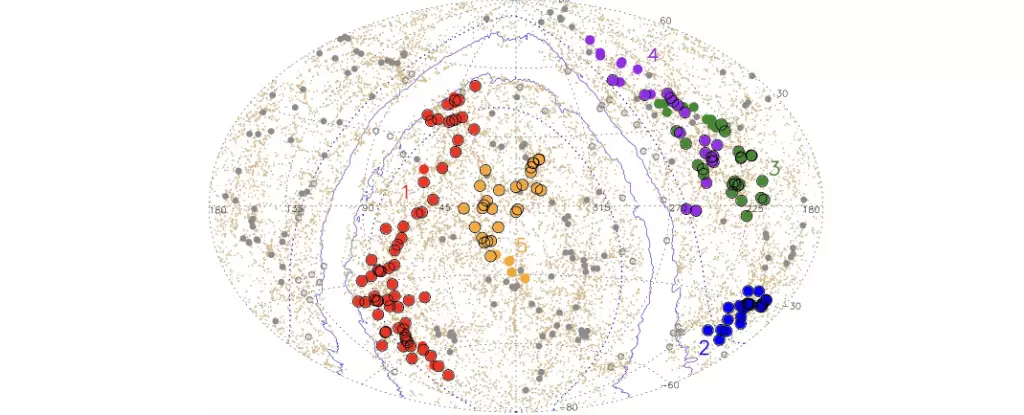The quest to unravel the mysteries of the Universe is an ongoing and complex endeavor. To gain a deeper understanding of this vast cosmos, one must consider not just individual galaxies, but also the immense structures that encompass them. Superstructures, such as Quipu, represent the largest aggregations of matter within the Universe and play a crucial role in shaping our cosmological models. This article delves into the discovery of Quipu, its implications for our understanding of cosmology, and the underlying mechanics that govern such colossal formations.
The Giant Quipu: An Overview
Discovered through meticulous research led by Hans Bohringer of the Max Planck Institute, Quipu is noteworthy not only for its staggering mass—approximately 200 quadrillion solar masses—but also for its incredible length of over 400 megaparsecs, equating to over 1.3 billion light-years. This astonishing scale offers a paradox: although astronomers routinely handle vast numbers and distances, the sheer size of Quipu can still be a conceptual challenge. Such structures are not mere curiosities; they represent vital pieces of the cosmic puzzle.
Quipu’s designation draws inspiration from the Incan system of knotted strings used for record-keeping. Just as knots convey information in a quipu, the interconnections between galaxies within superstructures like Quipu provide insights into the threads that weave the fabric of space-time. Understanding Quipu’s properties unlocks pathways to comprehending the fundamental forces and processes that govern the evolution of galaxies and, by extension, the Universe itself.
Superstructures are characterized by their collective composition of galaxy clusters and superclusters. These formations defy prior models of cosmic evolution and challenge theorists to adjust their frameworks to accommodate such immense aggregates. The monumental scale of Quipu, along with the four other superstructures identified in the research, holds approximately 45 percent of all galaxy clusters and 30 percent of the total number of galaxies within their volume.
The classification of these structures is expected to evolve as new methodologies and technologies emerge. For instance, the Cosmic Large-Scale Structure in X-rays (CLASSIX) Cluster Survey utilized X-ray emissions to map these colossal structures. X-ray emissions are invaluable for this purpose, as they pinpoint the densest areas of matter concentration, thereby allowing astronomers to trace the complex gravitational interplays affecting cosmic matter.
The Impact of Superstructures on Cosmological Measurements
The significance of superstructures extends beyond their mere existence; they leave profound imprints on cosmological observations, which can skew our understanding of key phenomena like the Cosmic Microwave Background (CMB)—a relic radiation from the Big Bang that provides a snapshot of the Universe’s infancy. The size and gravitational influence of superstructures can induce fluctuations in CMB readings, making the task of accurately interpreting this cosmic data immensely challenging.
Moreover, the influence of superstructures on the Hubble constant—an essential measure of the Universe’s expansion rate—merit critical examination. The local peculiar motions of galaxies, which are influenced by the gravitational forces exerted by superstructures, complicate our understanding of universal expansion. Accurate determinations of the Hubble constant are fundamental in the field of cosmology, as they offer clues about the fate of the Universe itself.
The discovery of Quipu and its superstructural counterparts necessitates a reevaluation of existing cosmological models and encourages future investigations into their characteristics. Beyond merely cataloging these gigantic structures, researchers should also assess how their existence influences the morphology and evolution of galaxies. For example, the surrounding environment can significantly affect the star formation rates within the galaxy clusters, thereby shaping their destiny.
As researchers continue to uncover the dynamics of superstructures, it becomes evident that they are not permanent fixtures within the cosmic landscape. Rather, their transient nature suggests a future where superstructures break apart into collapsing clusters, reflecting the ever-evolving stage of cosmic evolution. This notion raises questions about the lifecycle of galaxies and how environmental changes might dictate their development over eons.
The colossal nature of structures such as Quipu underscores their critical role in cosmological research. To transcend the limitations of current knowledge, it is imperative to embrace the complexity that these structures introduce into our understanding of the Universe. As we continue to investigate their properties and influences, we will sharpen our grasp of cosmic evolution. The intricacies of superstructures beckon a renewed commitment to exploration, discovery, and understanding—an endeavor that is as expansive as the Universe itself.


Leave a Reply